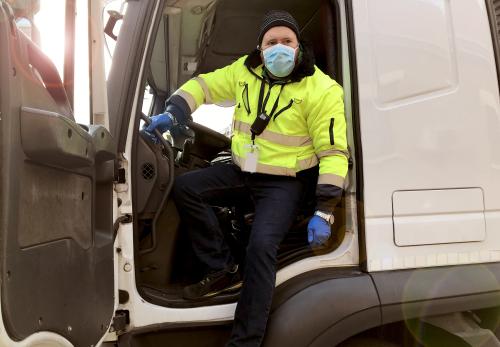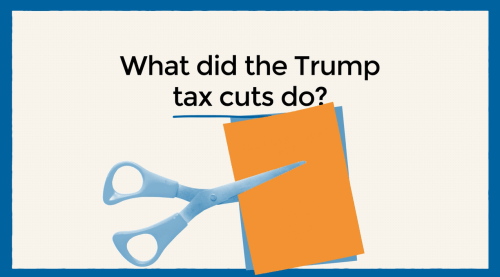This report was developed for our partners at Brookings Mountain West; the original version was published on their site on July 19, 2021.
Abstract
In this brief we examine work and work-based policies in Las Vegas, Nevada – a theme that emerged strongly from focus group data collected in the fall of 2019. The middle-class Americans we talked with were concerned about upward mobility, the changing landscape of work as a result of automation and skills training, scheduling uncertainty, and employee benefits like time off and paid leave. The COVID-19 pandemic highlighted and exacerbated these pre-existing issues for many workers. Much of the policy agenda in the last year has been understandably reactionary, as policymakers addressed immediate issues such as unemployment insurance, keeping workers safe, and emergency economic relief. More than a year later, it’s helpful to return to the concerns that were bubbling to the surface in 2019 – and reflect on what’s left to do, structurally, to strengthen our system, support workers, and move forward from the pandemic. To this end, we suggest several policy solutions – such as raising the minimum wage, investing in workers’ skills and education, providing paid leave, and encouraging flexibility.
- Introduction
- Precarity pre-COVID-19
- Unemployment during the COVID-19 recession
- The road to recovery?
- Next steps and policy solutions
- Conclusion
Introduction
In fall of 2019, the Brookings Future of the Middle Class Initiative conducted focus groups1 with over 120 middle-class Americans across five locations: Wichita, Kansas, Houston, Texas, Prince George’s County, Maryland, Central Pennsylvania, and Las Vegas, Nevada, with the goal of gaining a fuller understanding of the issues facing the American middle class.
This report specifically draws on the focus group data collected in Las Vegas, which is the 28th largest metropolitan area in the country, with racial diversity matching that expected for the nation by the year 2060.2 In Las Vegas, we conducted six focus groups with over 60 participants. Participation in the focus groups was limited to working age (25-64 years) individuals in the United States.
Las Vegas remains an interesting place for policy research for a few reasons; first, the metro area is very diverse, with significant Hispanic or Latino (33%), Black or African American (12%), and Asian (7%) populations.3 In Las Vegas, focus groups were conducted with Black, Hispanic, and white women, as well as Hispanic men. The participants in the focus groups were stratified by race and gender which provided the opportunity to examine responses through a race/gender lens.
Second, the COVID-19 pandemic adversely affected many of the industries that serve as the backbone of Las Vegas’ economy – service and gig work, leisure, and hospitality – making it an interesting case study of how these industries could bounce back post-COVID. Muro, Maxim, & Whiton (2020) show that 24.2 million Americans work in industries considered at highest risk from COVID-19, of which “leisure and hospitality” accounts for 16.3 million jobs. Within the Las Vegas Metropolitan Statistical Area (MSA), 342,050 jobs were expected to be at risk of suffering disruption as a result of the global pandemic – representing 33.8% of the workforce in industries under considerable risk.4
Lastly, while the desire for more work-time flexibility and personal control over time was raised in focus groups in all the sites, in the Las Vegas focus groups, work and workplace issues were especially salient. Participants raised issues surrounding employment laws, workplace policies, scheduling practices, prospects for mobility, and job security. To this end, Las Vegas presents a unique opportunity to examine how workplace policies and precarity around employment and scheduling impact marginalized groups in these particular industries.
Precarity pre-COVID-19
In Las Vegas, the middle-class Americans we talked with felt a lack of control over their time, which often stemmed from current workplace practices surrounding short-notice scheduling, a lack of paid leave, limited access to remote work, as well as employment laws in the state of Nevada. They expressed difficulty in finding jobs that paid well, and often perceived few prospects for upward mobility. Many felt as though their outdated skills, the return on investment for education, and changes to the future of work such as automation, left them with little financial security or opportunity. The themes that arose from the focus groups are explored in the sections that follow.
Lack of Control
Many of the participants we talked with expressed a lack of control over their own employment and time;5 they were often at the whim of their employers. They told stories of surprise scheduling with no notice, unexpected lay-offs, and high expectations coupled with low pay. Many felt like they had to show up and always be on their toes, or ready with a back-up option—a side gig or another employment opportunity—if something were to happen.
Nevada is an “at-will” employment state,6 meaning that an employer is able to let go of an employee for any reason, without notice, and without needing to have just cause for the decision. Nevada is also a right-to-work state,7 which means that employees are not required to join a union as a condition of employment. The impact of these laws was evident from our conversations. As Lilly, who is currently studying and working in Las Vegas, pointed out, “They can fire you for any reason. They don’t need a reason.” Caroline shared “I haven’t had the best experiences with employment [in Las Vegas]. I just don’t see any future [here]…In Vegas… they can fire you for anything.” Similar sentiments were shared by many other focus group members.
The participants also describe situations where they were let go without notice, which left them feeling helpless with nowhere to turn, as they were not protected by a union or by the law in these circumstances. Fiona, who works in advertisement and marketing, shared, “…my current employer recently purchased another company, and with that comes the possibility of 800 layoffs.” She added that this uncertainty about her future makes her “nervous” about having to “survive unemployment.” In the same focus group, Kim shared a similar experience with being let go unexpectedly: “I was out sick, and they called me, and they were like, ‘We’re going to have to let you go.’”
As Lilly explained, there are not many options for workers when they are let go in Nevada. She stated, “I didn’t have money to hire [an employment lawyer], but they usually rule in favor of the employer, not the employee.” This constant anxiety led some to seek back-up options to feel secure in their employment. Martin, a father to young children, mentioned that he is “perfectly happy” with what he is doing for work now and that he is on good terms with his employer. However, given past experiences, he says he “always stays on Craigslist looking for another job, just to be prepared,” adding that workers need to stay on their toes “just in case” because “you never know” if your employment will be terminated.
Upward Mobility, Skills Acquisition, and Automation
As we documented in a previous analysis,8 the middle class has experienced sluggish wage growth, near-stagnant wage increases, and declining odds of upward mobility since the late 1970’s. Much of this trend can be attributed to worker power—or lack thereof—but automation, skills, and education also play a role. In our focus groups, we heard concerns about upward mobility, promotions and fair wages, competition in the job market due to the demand for higher skills, and the threat of automation displacing workers or wiping out entire industries.
Elenore and others in the focus group described limited opportunities for promotion, which left them and their families feeling discouraged. Dissatisfaction with pay was also a common refrain. Elenore’s mother is in a “supervisory role,” which Elenore described was asking her to “do X, Y, and Z and more.” As for her responsibilities, “she opens, she closes, and she’s training people, and she’s still getting paid at the capacity of an entry-level worker.” When the moderator asked if participants felt that they and their families were financially secure at this current time, Teresa, who holds an associate’s degree and works in home care, replied, “They don’t pay you enough. I’m applying [for jobs] and I have a phenomenal resume.” Teresa stated that she is competitive in the job market and feels as though she could get any of the jobs she’s applying for and has received great feedback: “Everyone’s calling me” to interview, as she put it. But she described being struck by the low wages, exclaiming that they are “crazy” for offering such a low salary for her level of experience.
Mariana, who studied to become a paralegal, expressed, “It scares me that there’s so many companies out there that are kind of shutting down on jobs wherever you go. My skills, they’re outdated compared to what is needed to keep up with in the world right now.” This concern over skills acquisition was echoed across all focus groups in Las Vegas as participants worried about the job market, and the type of return on education that they could expect, not just for themselves, but also for their close friends and family.
Automation and technology have the potential to create jobs and increase productivity and efficiency, but also present the risk of displacing workers, especially workers9 in the production, food service, and transportation sectors. When asked if he had any current or future concerns, Evan, who drives for Uber, replied, “Yes…Uber eventually is going to be eliminated…my concerns are with technology […] we have self-driving cars now, so I don’t think we’re going to be here that long.” Discussion surrounding upward mobility, skills acquisition, and the threat of automation revealed deep-seated anxieties over participants’ futures and financial security.
Scheduling, Time Off, and Paid Leave
Participants also pointed to short notice scheduling and the lack of paid time off as a hindrance to their ability to plan ahead, attend important life events, and ultimately feel in control of their time.10 Over a quarter11 of employees in the leisure and hospitality industry receive their schedules less than a week in advance. Workers in these industries may also be12 put on call or taken off the schedule at the last minute – which makes it difficult to even predict how many hours they may be working per week. Maria detailed an experience she had while working in retail, she says:
“[retail]…it’s the kind of job where they require overtime, and then somebody calls out and you’re the ‘go to’ guy you’re going to get called in. And it doesn’t matter if that day someone passed away or someone had a birthday. I mean, last year my grandmother passed away, and I was called into work, and I couldn’t go to her funeral because I had bills to pay.”
When we talked with these middle-class Americans, Nevada did not have a state-wide paid leave policy. The federal FMLA13 guarantees unpaid time off for most employees in the U.S., but at the time of our focus groups, only 12 states and the District of Columbia,14 as well as a few jurisdictions, mandated that employers in their region provide paid leave. While many employers do offer paid leave to their employees, when examining the breakdown of paid leave by wage, occupation, and employer size, we see wide gaps in access and availability. For example, only 61% of workers in services such as food and beverage preparation, cleaning and building service, and personal services—barbers, flight attendants, and childcare workers—have access to paid sick leave. For other types of paid leave, such as paid parental leave, access is even more sparse for those in these service industries, with only 14% having access to paid parental leave in 2020. As we discuss below, in late-2019, Nevada implemented a paid leave policy which took effect on January 1, 2020.
Kristina, who was pregnant with her second child when we spoke with her, recounted her own experience in Nevada before the paid leave policy took effect, stating, “the only thing that they provide or allow in Nevada is six weeks of unpaid leave.” Thankfully, Kristina was able to piece together benefits from her employer to make it work. She added that she is “really excited” because her job recently allowed employees to work remotely part of the time, which will allow her to be home with her three-year-old and her newborn, and “still make money.” However, to make this transition realistic, and to take time to recover after the birth of her child, Kristina stated that, “I’m using up my own vacation time…I’m using up my own sick time.”
Unemployment during the COVID-19 recession
In March 2020, the pandemic drastically affected the leisure and hospitality industries that serve as the backbone of the Las Vegas economy. In the depths of the pandemic, Nevada’s unemployment rate peaked at 28.2% in May 2020, nearly double the national rate of 14.7% for the same month.15 According to 2019 BLS data,16 more than a quarter of Las Vegas residents are employed in these industries, and from March 2020 to April 2020, employment in these sectors decreased from 290,400 to 140,000, reaching a low of 127,000 in May 2020.

The trends in the leisure and hospitality industry in Las Vegas mirror those across the U.S. Employment for workers in this sector took a major hit at the start of the pandemic and still has not recovered.

Six months later, the pandemic’s effects on the leisure and hospitality industry were clear. Travel and tourism had taken a significant hit. By November 2020, only 47%17 of Las Vegas’s hotel or motel rooms were occupied, a significant decrease from November 2019 when 88% of the rooms were filled. In the same time period, Las Vegas’ Harry Reid International Airport saw 59% fewer travelers,18 and the city had 52% fewer tourists.
In the Las Vegas metropolitan area, the unemployment rates for all industries skyrocketed, increasing from 3.6% in February 2020 to 6.9% in March and jumping to 33.3% in April 2020, significantly higher than the national average of 14.8%. By November 2020, when we start to see some levelling out of the unemployment trends, Las Vegas had experienced an almost 8 percentage point19 change in unemployment from the previous year.
Klein and Smith20 suggest that Las Vegas, and other hard-hit cities, are likely experiencing negative spillover effects. They explain, “In the aggregate, the devastation of a core industry can mean the decline of others nearby, like with manufacturing in the Rust Belt in the second half of the twentieth century. As a result, metropolitan areas concentrated in hard-hit industries are likely to see negative ripple effects throughout their economy (lower tax revenue, less spending, etc.).” They use this example to illustrate the situation in Las Vegas: an unemployed casino worker is less likely to buy new clothes. Spillover effects mean that because of the severe effect on employment in the leisure and hospitality industry, the entire economy has suffered.
These effects are especially worrisome for groups that already faced challenges pre-pandemic. Klein and Smith’s research21 also found that harder hit metropolitan areas tend to have larger Hispanic or Latino populations, which means the pandemic is exacerbating existing disparities like the racial wealth gap for Hispanic or Latino families. Furthermore, the Treasury Department denied stimulus checks22 to people married to immigrants without a social security number and to children with a non-citizen parent. This decision disproportionately hurt Latino families, creating further inequalities.
COVID-19 did not only lead to unemployment. Drs. Elizabeth Ananant and Anna Gassman-Pines23 sent daily text messages to 1,000 workers in the retail, food, service, and hospitality industries with young children from February to April 2020. While not localized to Las Vegas, their study began before the pandemic, and their research shows how the pandemic affected the jobs of workers in this sector. They find that by the end of March 2020, 70% of workers were working less: 41% were laid off and 31% had their hours reduced. This shows how underemployment and reduced hours were also by-products of the pandemic. Coupled with a lack of paid sick leave, hazard pay, consistent scheduling, and other benefits – issues that existed pre-pandemic – low-wage workers faced difficult, unsustainable, and sometimes dangerous conditions when they were able to work.
The road to recovery?
Now, a year later, Las Vegas may be on the road to recovery. As of March 2021, the unemployment rate reached a post-pandemic low of 8.8%, but it was still more than double what it was a year ago, in February 2020. Nevada’s current rate is also higher than the U.S. unemployment rate of 6.1%.24 This recovery lines up with the slower recovery rate of the leisure and hospitality across the U.S. In April 2021, unemployment in leisure and hospitality industries sits at almost 11%,25 nearly double the overall unemployment rate.

Tourism is also beginning to recover in Las Vegas. While the number of tourists was still down about 27% from pre-pandemic levels, 2.6 million visitors26 traveled to the city in April 2020, a 15.4% increase since March 2021, and more than double the 1.25 million visitors who came in December 2020. Casinos in Vegas also reported the second month in a row of winnings more than $1 billion, a sign that people are feeling more comfortable returning to pre-pandemic leisure activities.
Next steps and policy solutions
The pandemic has highlighted and exacerbated pre-existing concerns for many workers. Much of the policy agenda in the last year has been understandably reactionary, as policymakers were forced to address immediate issues such as unemployment insurance, keeping workers safe, and emergency economic relief. As we’ve shown, there are undoubtedly positive signals that the Las Vegas economy is returning to normal. A new “right to return” law also provides assurance that workers in the leisure and travel industry displaced by the recession can get their old jobs back.27 The question is, should the old “normal” be the goal, or can we do better?
For the remainder of this brief, we discuss potential policy solutions to these issues that were pertinent pre-COVID, including mobility and wages, skills and education, scheduling, and paid leave. At the onset of the pandemic, these types of issues were brought to the forefront. Many were astounded by the fragility of our system, which proved unable to stand up to the pandemic. More than a year later, it is helpful to return to the concerns that were bubbling to the surface in 2019 – and reflect on what’s left to do, structurally, to strengthen our system, support workers, and move forward from this pandemic.
Raising the Minimum Wage
In 2019, Nevada passed Assembly Bill 45628 which provides a $0.75 increase29 in the minimum wage each year until it reaches $12 per hour for employees who do not receive qualifying health benefits from their employers and $11 per hour for employees who do receive these benefits from their employers. In July 2021, the minimum wage in Nevada will increase to $9.75 and $8.75 per hour for employees in the two respective groups. This means that Nevada’s minimum wage will reach the $12 and $11 per hour thresholds, depending on employees’ health benefits, by 2024. This is in line with what we suggest federally in A New Contract with the Middle Class—a $12 per hour minimum wage floor.30
Alongside the increase in minimum wage, Nevada is also increasing its overtime thresholds.31 The state is one of the only states that recognizes both daily and weekly overtime, meaning that employees making under $14.63 per hour without health benefits and under $13.13 per hour with health benefits can earn overtime pay on days that they work more than 8 hours as well as during weeks where they work more than 40 hours. Instituting these policies across the U.S. are small ways that can help workers fully recover from the pandemic.
Paid Leave for Any Purpose
We heard many participants in focus groups share that before the pandemic they had little control over their time or schedules. This has been a problem around the country during COVID-19, as many workers navigated needing to stay home from work because of the virus without access to paid time off. The U.S. instituted a temporary policy through the Families First Coronavirus Response Act (FFCRA)32 that allocated a certain number of days off to eligible workers. The American Rescue Plan Act33 restarted and expanded several of these policies but did not make them permanent. Nevada is already a step ahead of the federal government, with a state-wide paid leave policy34 implemented on January 1, 2020, just before the pandemic. Their paid leave policy grants eligible employees up to 5 days of paid leave per year, which can be used for any purpose. While 5 days of leave is better than none, it is still significantly less time than the CDC recommended workers quarantine after exposure to COVID-19. Additionally, Nevada’s current policy35 does not apply to temporary, seasonal, or on-call employees, companies with less than 50 employees, or companies that are under two years old.
While we argue that this policy should be expanded, it does provide an interesting framework for a federal policy. As we argue in A New Contract with the Middle Class, requiring all employers to provide at least 20 days of paid leave36 to all employees would go a long way toward improving employee work-life balance, giving workers more control over their schedules, and ensuring that they, and their families, remain in good health. In combination with the 20 days of paid leave, we propose a paid leave account to adequately support new parents with the birth of a child. The account would be situated within the existing social security system, would be linked to wages, and would cover up to 12 weeks of leave.
Training and Education
We also propose a lifelong learning account37 that could be used for living expenses and tuition for an approved program of education or training to upgrade skills. While research suggests38 that automation is unlikely to lead to mass unemployment, it is still expected to displace some workers in the short run. Lifelong learning accounts coupled with tax incentives for corporations to train their workers would support continued training. It would also prepare workers for this transition, preventing them from having to go on unemployment or piecing together low-paying jobs to make a living.
As higher education an important factor in upward mobility,39 we also propose making post-secondary education more affordable for the middle class. Our proposal, “Scholarships for Service,”40 would allow students to attend two-years at a post-secondary institution for free in exchange for one year of national service. This will allow young Americans from all walks of life to obtain a college degree, which is needed to stay competitive in today’s job market, without accumulating too much debt.
Remote Work and Flexibility
The COVID-19 pandemic and ensuing lock-down proved that remote work is possible and much more effective than previously perceived. Prior to the pandemic, remote work41 was rare and usually concentrated in high-paying industries, such as management, business, and financial services. Over 60%42 of working Americans in the top 25% of the earnings distribution were able to work from home in 2017 and 2018, compared to 9% in the bottom quartile. If remote work does in fact expand more permanently as a result of the pandemic, it would provide greater flexibility for those who work in jobs where telework is feasible.
Other workers, such as those in leisure and hospitality, construction, and transportation, are much less likely to have that option. These workers are also the most likely43 to experience unpredictable work and short notice scheduling. Requiring that such workers be provided with their schedules at least two weeks in advance is one solution as proposed in the Schedules That Work Act,44 first introduced in 2015 by Senator Elizabeth Warren and Representative Rosa DeLauro. These are only a selection of policies that could ease the time squeeze. Ultimately, giving workers more control over their hours is a high priority among the middle-class Americans we spoke with.
Conclusion
If we want work to be better after the pandemic, it is important to understand the concerns of workers before it. Middle-class Americans in Las Vegas put concerns about work – flexibility, security, prospects, pay – at the heart of our focus group discussions. Policies to make work more rewarding, more stable, more secure and with more prospects of upwards mobility are now on the table. For example, raising the minimum wage, investing in workers’ skills and education, providing paid leave, and encouraging fair flexibility offer the potential for a better working life for middle-class workers in Las Vegas, but also across America.
Full PDF version of this report available here.
-
Acknowledgements and disclosures
The authors thank William E. Brown, Jr., UNLV Director of Brookings Mountain West, and Caitlin J. Saladino, Director of Strategic Development at Brookings Mountain West, for their input and Tiffany N. Ford, Post-Doctoral Fellow at Brookings, and Aaron Klein, Senior Fellow at Brookings, for their review and comments. The authors also acknowledge Ashley LeClair, Brookings Mountain West, who provided valuable editing and design expertise in the final production of this report.
-
Footnotes
- Voices of the middle class. (2020). Brookings Intuition, Retrieved from https://www.brookings.edu/interactives/voices-of-the-middle-class/.
- Kolko, J. (2017, June 22). 40 years from now, the U.S. could look like Las Vegas demographically, at least. FiveThirtyEight, Retrieved from https://fivethirtyeight.com/features/40-years-from-now-the-u-s-could-look-like-las-vegas.
- QuickFacts: (2019, July 1). Las Vegas city, Nevada. The U.S. Census Bureau, Retrieved from https://www.census.gov/quickfacts/fact/table/lasvegascitynevada/PST045219.
- Muro, M. Maxim, R., & Whiton, J. (2020, March 17). The places a COVID-19 recession will likely hit hardest. Brookings Institution. Retrieved from https://www.brookings.edu/blog/the-avenue/2020/03/17/the-places-a-covid-19-recession-will-likely-hit-hardest/.
- To read more about how focus group participants in all locations expressed concerns over their time and time use, see: Ford, T., Silva, J., Welch, M., & Sawhill, I. (2021, February). No time to spare: Exploring the middle class time squeeze. Brookings Institution. Retrieved from https://www.brookings.edu/research/no-time-to-spare-exploring-the-middle-class-time-squeeze/.
- Policy and Program Report: Labor and Employment. (2016, April). Research Division, Nevada Legislative Counsel Bureau, Retrieved from https://www.leg.state.nv.us/Division/Research/Publications/Pandpreport/02-LE.pdf.
- Right to work states. (2020). National Right to Work Legal Defense Foundation, Retrieved from https://www.nrtw.org/right-to-work-states/.
- Reeves, R. & Sawhill, I. (2020, September). A New Contract with the Middle Class. Brookings Institution. Retrieved from https://www.brookings.edu/wp-content/uploads/2020/10/FMCi-Middle-Class-Contract-DIGITAL-VERSION.pdf.
- Muro, M. Maxim, R., & Whiton, J. (2019, January 24). Automation and Artificial Intelligence: How machines are affecting people and places. Brookings Institution. Retrieved from https://www.brookings.edu/research/automation-and-artificial-intelligence-how-machines-affect-people-and-places/.
- To read more about how focus group participants in all locations expressed concerns about short-notice scheduling, paid time off, and access to remote work, see: Ford, T., Silva, J., Welch, M., & Sawhill, I. (2021, February). No time to spare: Exploring the middle class time squeeze. Brookings Institution. Retrieved from https://www.brookings.edu/research/no-time-to-spare-exploring-the-middle-class-time-squeeze/.
- Economic News Release: Table 5. How far in advance workers knew their work schedules by selected characteristics, averages for the period 2017-2018. (2019, September 24). U.S. Bureau of Labor Statistics, Retrieved from https://www.bls.gov/news.release/flex2.t05.htm.
- Guyot, K. & Reeves, R. (2020, August 18). Unpredictable work hours and volatile incomes are long-term risks for American workers. Brookings Institution. Retrieved from https://www.brookings.edu/blog/up-front/2020/08/18/unpredictable-work-hours-and-volatile-incomes-are-long-term-risks-for-american-workers/.
- Family and Medical Leave Act. (updated 2020, July 16). U.S. Department of Labor, Retrieved from https://www.dol.gov/agencies/whd/fmla.
- Desilver, D. (2020, March 12). As coronavirus spreads, which U.S. workers have paid sick leave – and which don’t? Pew Research Center. Retrieved from https://www.pewresearch.org/fact-tank/2020/03/12/as-coronavirus-spreads-which-u-s-workers-have-paid-sick-leave-and-which-dont/.
- Snyder, R. & Rindels, M. (2020, May 22). Nevada posts 28.2 percent unemployment rate, highest in the nation. The Nevada Independent. Retrieved from https://thenevadaindependent.com/article/nevada-posts-28-2-percent-unemployment-rate-highest-in-nation.
- Economy at a Glance: Las Vegas-Paradise, NV. (2020, July 16). U.S. Bureau of Labor Statistics, Retrieved from https://www.bls.gov/eag/eag.nv_lasvegas_msa.htm.
- Klein, A. & Smith, E. (2021, February 4). Explaining the economic impact of COVID-19: Core industries and the Hispanic workforce. Brookings Mountain West. Retrieved from https://digitalscholarship.unlv.edu/brookings_policybriefs_reports/2/.
- Ibid.
- Klein, A. & Smith, E. (2021, February 4). Explaining the economic impact of COVID-19: Core industries and the Hispanic workforce. Brookings Mountain West. Retrieved from https://digitalscholarship.unlv.edu/brookings_policybriefs_reports/2/.
- Ibid.
- Ibid.
- Klein, A. & Gelrud Shiro, A. (2020, October 1). The COVID-19 recession hit Latino workers hard. Here’s what we need to do. Brookings Intuition. Retrieved from https://www.brookings.edu/blog/how-we-rise/2020/10/01/the-covid-19-recession-hit-latino-workers-hard-heres-what-we-need-to-do/.
- Ananat, E. O. & Gassman-Pines, A. (2020, May 19). Of the 1,000 workers we texted, nearly all are in trouble. New York Times. Retrieved from https://www.nytimes.com/2020/05/19/opinion/coronavirus-paycheck-guarantee-act.html.
- News Release: The Employment Situation – May 2021. (2021, June 4). U.S. Bureau of Labor Statistics, Retrieved from https://www.bls.gov/news.release/pdf/empsit.pdf.
- Labor Force Statistics from the Current Population Survey. (2021, June 4). U.S. Bureau of Labor Statistics, Retrieved from https://www.bls.gov/web/empsit/cpseea31.htm.
- Associated Press. (2021, May 28). Jammed sidewalks, fewer masks: Las Vegas shows signs of recovery heading into Memorial Day weekend. USA Today, Retrieved from https://www.usatoday.com/story/travel/news/2021/05/28/las-vegas-casino-win-masks-economic-recovery-signs-memorial-day/5246376001/.
- “Nevada Enacts Right to Return Law for Certain Workers Laid Off During and After COVID-19 Pandemic” Retrieved from https://www.natlawreview.com/article/nevada-enacts-right-to-return-law-certain-workers-laid-during-and-after-covid-19.
- AB456. (Updated 2021, June 6). Nevada Electronic Legislative Information System, Retrieved from https://www.leg.state.nv.us/App/NELIS/REL/80th2019/Bill/6870/Overview.
- Labor Commissioner releases 2021 minimum wage and daily overtime bulletins. (2021, April 1). Nevada Association of Employers, Retrieved from https://www.nevadaemployers.org/labor-commissioner-releases-2021-minimum-wage-and-daily-overtime-bulletins/.
- Reeves, R. & Sawhill, I. (2020, September). A New Contract with the Middle Class. Brookings Institution. Retrieved from https://www.brookings.edu/wp-content/uploads/2020/10/FMCi-Middle-Class-Contract-DIGITAL-VERSION.pdf.
- Labor Commissioner releases 2021 minimum wage and daily overtime bulletins. (2021, April 1). Nevada Association of Employers, Retrieved from https://www.nevadaemployers.org/labor-commissioner-releases-2021-minimum-wage-and-daily-overtime-bulletins/.
- Sawhill, I. & Welch, M. (2020, July 2). Reopening America: We shouldn’t reopen the economy without paid sick and family leave. Brookings Institution. Retrieved from https://www.brookings.edu/blog/up-front/2020/07/02/reopening-america-we-shouldnt-reopen-the-economy-without-paid-sick-and-family-leave/.
- The American Rescue Plan. (2021, March0. White House, Retrieved from https://www.whitehouse.gov/wp-content/uploads/2021/03/American-Rescue-Plan-Fact-Sheet.pdf.
- Nevada Sick Leave: What you need to know. (2021). Business & Learning Resources, Retrieved from https://www.blr.com/HR-Employment/Benefits-Leave/Sick-Leave-in-Nevada.
- Ibid.
- Van Drie, H. (2021, May 19). Guarantee 20 days of paid leave. Brookings Institution. Retrieved from https://www.brookings.edu/blog/up-front/2021/05/19/guarantee-20-days-of-paid-leave/
- Sawhill, I. & Guyot, K. (2020, August). The Middle Class Time Squeeze. Brookings Institution. Retrieved from https://www.brookings.edu/wp-content/uploads/2020/08/The-Middle-Class-Time-Squeeze_08.18.2020.pdf.
- Bessen, J., Goos, M., Salomons, A., & and van den Berge, W. Automation: A guide for policymakers. Brookings Institution. Retrieved from https://www.brookings.edu/research/automation-a-guide-for-policymakers/.
- Greenstone, M., Looney, A., Patashnik, J., & Yu, M. (2013, June 26). Thirteen Economic Facts about Social Mobility and the Role of Education. Brookings Institution. Retrieved from https://www.brookings.edu/research/thirteen-economic-facts-about-social-mobility-and-the-role-of-education/.
- Nzau, S. (2021, May 26). Free college? Try Scholarships for Service. Brookings Institution. Retrieved from https://www.brookings.edu/blog/up-front/2021/05/26/free-college-try-scholarships-for-service/.
- Guyot, K. & Sawhill, I. (2020, April 6). Telecommuting will likely continue long after the pandemic. . Brookings Institution. Retrieved from https://www.brookings.edu/blog/up-front/2020/04/06/telecommuting-will-likely-continue-long-after-the-pandemic/.
- Economic News Release: Table 1. Workers who could work at home, did work at home, and were paid for work at home, by selected characteristics, averages for the period 2017-2018. (2019, September 24). U.S. Bureau of Labor Statistics, https://www.bls.gov/news.release/flex2.t01.htm.
- Guyot, K, & Reeves, R. (2020, August 18). Unpredictable work hours and volatile incomes are long-term risks for American workers. Brookings Institution. Retrieved from https://www.brookings.edu/blog/up-front/2020/08/18/unpredictable-work-hours-and-volatile-incomes-are-long-term-risks-for-american-workers/.
- Fact Sheet: The Schedules That Work Act of 2019. (2019, October 17). Elizabeth Warren, United States Senator for Massachusetts, Retrieved from https://www.warren.senate.gov/newsroom/press-releases/senator-warren-and-representative-delauro-announce-reintroduction-of-the-schedules-that-work-act.








